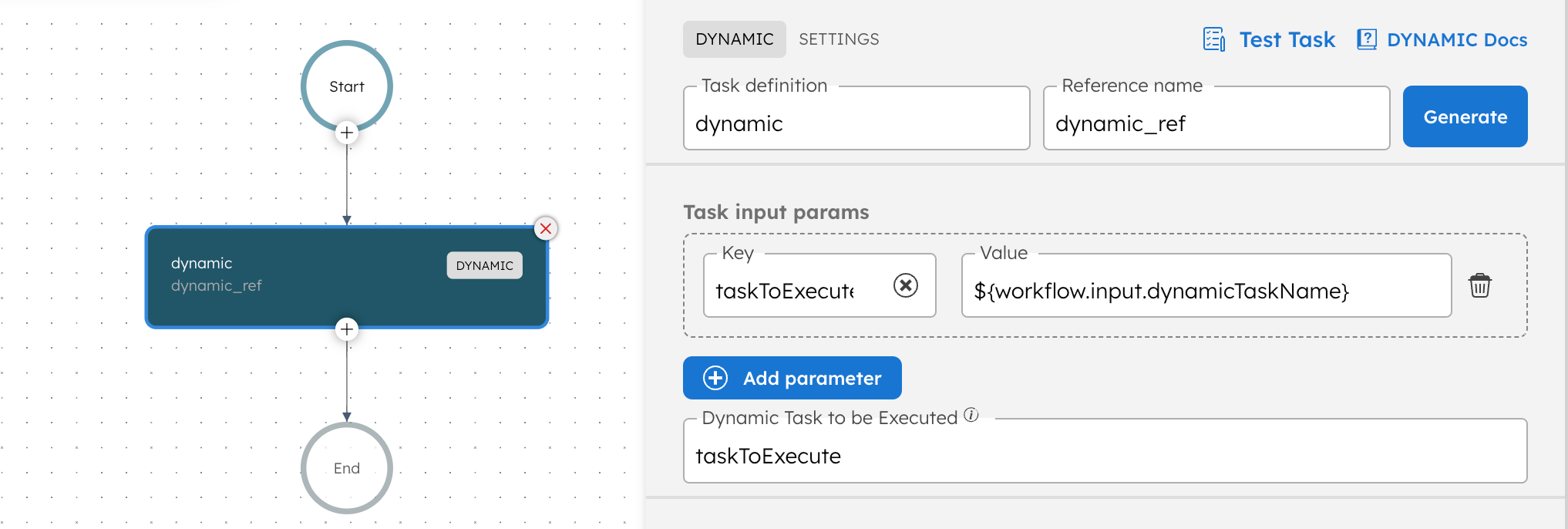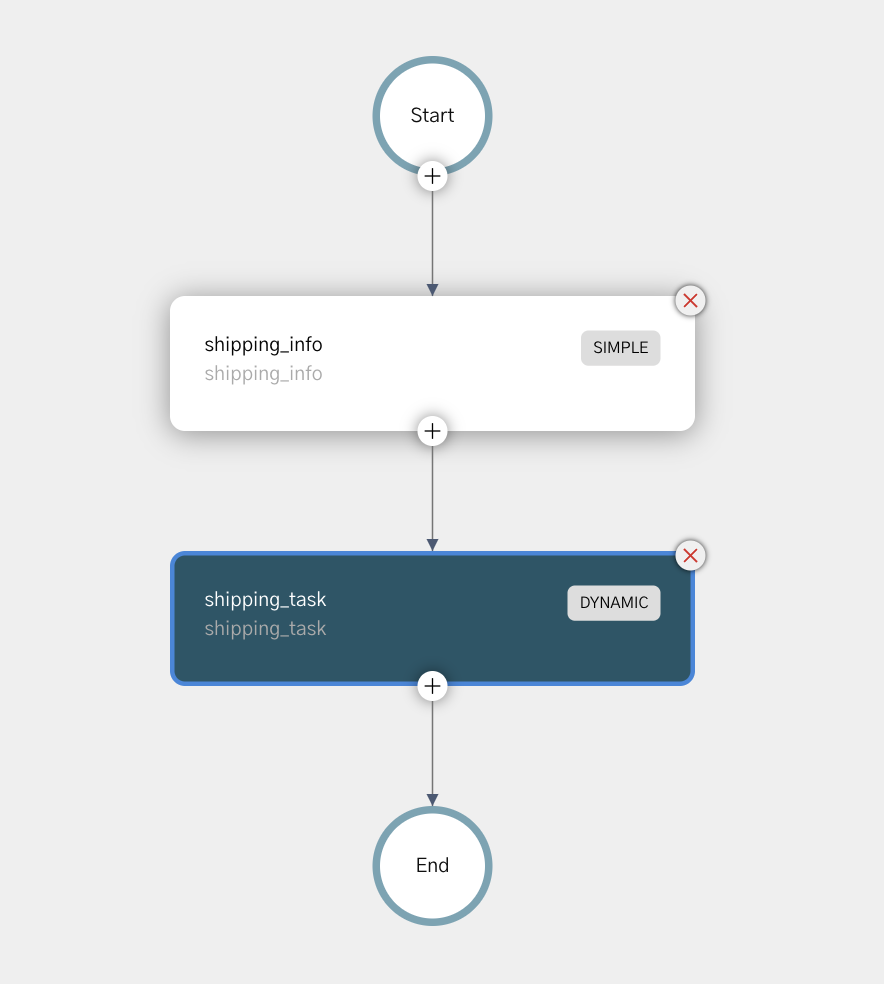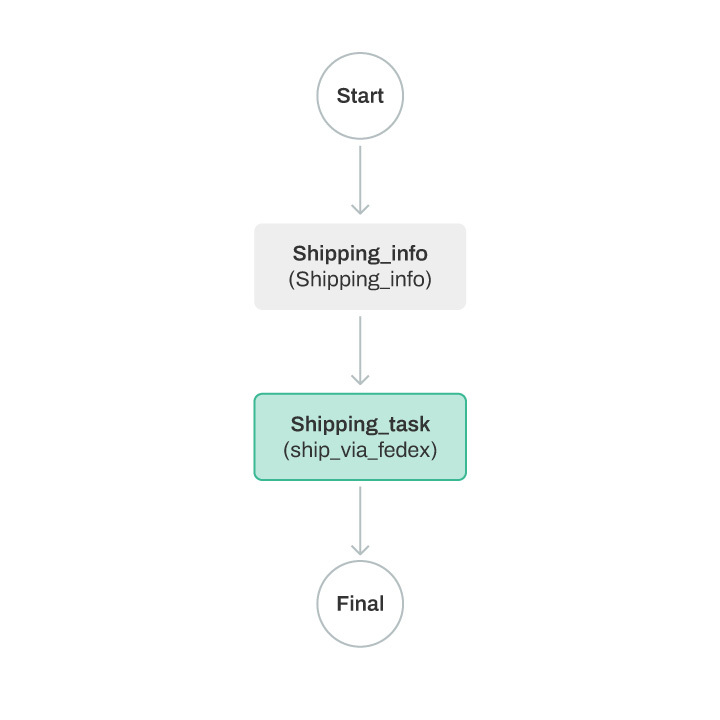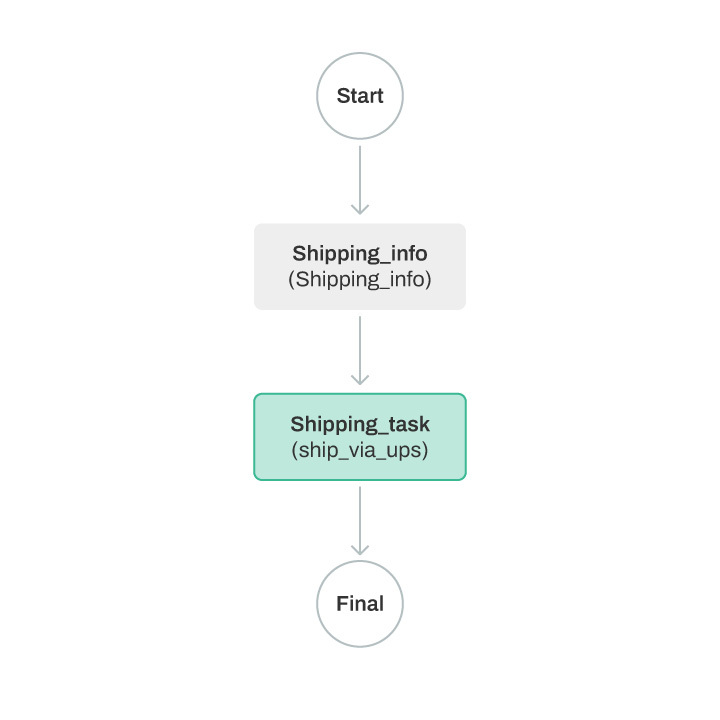Dynamic
The Dynamic task executes a registered task dynamically at run-time. It is similar to a function pointer in programming, and can be used in cases when the decision to execute which task will only be made after the workflow has begun. Unlike the Switch task, the Dynamic task offers flexibility without needing to update the workflow definition.
The Dynamic task accepts as input the name of a task, which can be a system task, a sub-workflow, or a custom Worker task registered on Conductor.
Task parameters
Configure these parameters for the Dynamic task.
| Parameter | Description | Required/ Optional |
|---|---|---|
| dynamicTaskNameParam | The input parameter key whose value is used to schedule the task. For example, "taskToExecute", which will then be specified as an input parameter in the Dynamic task. | Required. |
| inputParameters. taskToExecute | The name of the task that will be executed. It can be passed as a dynamic input. | Required. |
| inputParameters | Contains the inputs to the task that will be executed. | Required, depending on the task. |
The following are generic configuration parameters that can be applied to the task and are not specific to the Dynamic task.
Other generic parameters
Here are other parameters for configuring the task behavior.
| Parameter | Description | Required/ Optional |
|---|---|---|
| optional | Whether the task is optional. If set to true, any task failure is ignored, and the workflow continues with the task status updated to COMPLETED_WITH_ERRORS. However, the task must reach a terminal state. If the task remains incomplete, the workflow waits until it reaches a terminal state before proceeding. | Optional. |
Configuration for calling a sub-workflow
If the Dynamic task to be called is a Sub Workflow task, then taskToExecute must be set to SUB_WORKFLOW. The inputParameters for the Dynamic task should also include these fields:
- Using workflow name and version
- Using workflow definition JSON
// Dynamic task defintion
"inputParameters": {
"subWorkflowName":"someName",
"subworkflowVersion": "1"
}
Using the workflow definition JSON instead of the workflow name and version is useful when the sub-workflow has not been registered in the Conductor server beforehand. This option is ideal for constructing dynamic sub-workflows on the fly.
// Dynamic task defintion
"inputParameters": {
"subWorkflowDefinition":{ //subworkflow JSON definition}
}
Task configuration
This is the task configuration for a Dynamic task.
- All tasks
- Sub-workflows
{
"name": "dynamic",
"taskReferenceName": "dynamic_ref",
"inputParameters": {
"taskToExecute": "${workflow.input.dynamicTaskName}" // name of the task to execute
},
"type": "DYNAMIC",
"dynamicTaskNameParam": "taskToExecute" // input parameter key that will hold the task name to execute
}
{
"name": "dynamic",
"taskReferenceName": "dynamic_ref",
"inputParameters": {
"taskToExecute": "SUB_WORKFLOW",
"subWorkflowName": "${workflow.input.someName}", // the name of the sub-workflow to execute
"subWorkflowVersion": "1"
},
"type": "DYNAMIC",
"dynamicTaskNameParam": "taskToExecute"
}
Task output
During execution, the Dynamic task is replaced with whatever task that is called at runtime. The output of the Dynamic task will be whatever the output of the called task is.
Adding a Dynamic task in UI
To add a Dynamic task:
- In your workflow, select the (+) icon and add a Dynamic task.
- In Task input params, specify the task to execute by setting a value in the
taskToExecuteparameter. The value can be passed as a dynamic input (for example,${workflow.input.dynamicTaskName}).

Examples
Here are some examples for using the Dynamic task.
Using the Dynamic task in a workflow
In this example workflow, shipments are made with different couriers depending on the shipping address. The decision can only be made during run-time when the address is received, and the subsequent shipping task could be either ship_via_fedex and ship_via_ups. A Dynamic task can be used in this workflow so that the shipping task can be decided in realtime.
{
"name": "Shipping_Flow",
"description": "Ships smartly based on the shipping address",
"tasks": [
{
"name": "shipping_info",
"taskReferenceName": "shipping_info_ref",
"inputParameters": {},
"type": "SIMPLE"
},
{
"name": "shipping_task",
"taskReferenceName": "shipping_task_ref",
"inputParameters": {
"taskToExecute": "${shipping_info.output.shipping_service}"
},
"type": "DYNAMIC",
"dynamicTaskNameParam": "taskToExecute"
}
]
}
In the workflow, the shipping_info task generates an output that is used to determine which task is run in the Dynamic shipping_task task. The line "taskToExecute": "${shipping_info.output.shipping_service}" reads the shipping_service output from shipping_info. Here is the visual diagram of the same workflow:

During workflow execution, if the shipping_info task output is "shipping_service": "ship_via_fedex", the Dynamic shipping_task task will be replaced with the ship_via_fedex task:

If the shipping_info task output is "shipping_service": "ship_via_ups", the Dynamic shipping_task task will be replaced with the ship_via_ups task:
